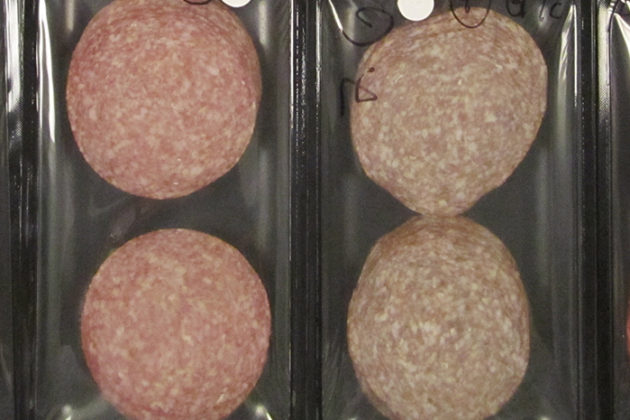Packaging of dry cured sausages – how to maintain colour and taste?

Nearly all meat and meat products in Norway are sold as pre-packaged. The consumers are selecting items with the right colour and quality. Appropriate packaging is crucial for reducing consumer complaints and food waste. We have now obtained knowledge on how sliced, packaged dry cured sausages should be treated under packaging, storage and retail display
Discoloration
Dry cured sausages contain the muscle pigment myoglobin, which combined with nitrite and lowering of the pH makes a red/pink colour of the final products. Most of Norwegian dry cured sausages are sliced and packaged in modified atmospheres. The gas is usually either all nitrogen or a blend of nitrogen and some carbon dioxide. However, during packaging operations it is unavoidable that some air with residual oxygen (O2) is incorporated in the headspace above the product. When transparent packages are illuminated, the slices of sausages can be discoloured. The extent of discoloration increases with higher light intensity, in particular when the light is blue.
Nofima has made designed experiments to find how much residual (O2) that is tolerable without the occurrence of discoloration. Dry cured sausages with starter cultures in the recipe has the beneficial feature of consuming residual O2 that has entered the package. The reduction of residual O2 is faster at room temperature (20 ºC) than in chilling facilities (4 ºC). The time needed to make the packages free of O2 was usually from a few days to a week. Results indicate that the limit for residual O2 to avoid discoloration is max. 0.3 – 0.4 %, often lower in packages at 4 than 20 ºC. The discoloration of dry cured sausages is irreversible, so that a gray/brown sausage never will turn back to red again.
Rancid taste
Dry cured sausages contain salt and are stored over a long time. Therefore, the sausages are prone to lipid oxidation. For other types of meat and meat products, oxidations of pigments and lipids are connected, and that is valid for dry cured sausages too.
We have used sensory analysis on odour, taste and colour for sliced, packaged salami, which was kept under light or in darkness, both at 4 or 20 °C. Some packages were added residual O2. Slices in packages which were free of O2, could be held in light or darkness at both temperatures without developing off-odour and off-taste. However, slices which were exposed simultaneously to residual O2 and light became rancid and discoloured. Rancid taste was detected not only in the top slice, but also in all slices throughout the stack.
More research
Nofima will continue to look for the causes why dry cured sausages are having different consumption of residual O2, and how the consumption can be increased. We believe that bacteria and enzymes play an important role in removing O2. In future work, the contribution from starter cultures will be clarified, as well as the impact of stimulating and inhibiting factors during processing of the sausages.
Measures by the producers
The experiments have shown that packages of sliced dry cured sausages must be almost free of residual O2 at the time when the packages are displayed under light in food stores. These sausages will not become discoloured or rancid. Producers of dry cured sausages should make specific gas measurements in various package and product combinations, to determine the time needed to remove O2. Spend sufficient holding time from packaging to light display. The packages should be made with a low gas:product ratio to minimize the volume of O2. Check that the packages are not leaking.
Most types of meat and meat products are sensitive to residual O2. For raw fermented sausages, we are in the lucky position that the producer can contribute with these measures to ensure that the products will reach the consumer in a state of high quality.
Facts about the projects
The present work was performed in the projects FoodMicro-Pack and Freshpack, both supported by the Foundation for Research Levy on Agricultural Products (FFL). FoodMicro-Pack is one of four strategic research programs at Nofima. Freshpack is an innovation project about the quality of cold cuts of meat for the period 2015-17. The latter project is managed by Nortura in collaboration with Multivac, Südpack, Praxair, NorgesGruppen, the Spanish research institute IRTA and Nofima.
Contact person
Research facilities
